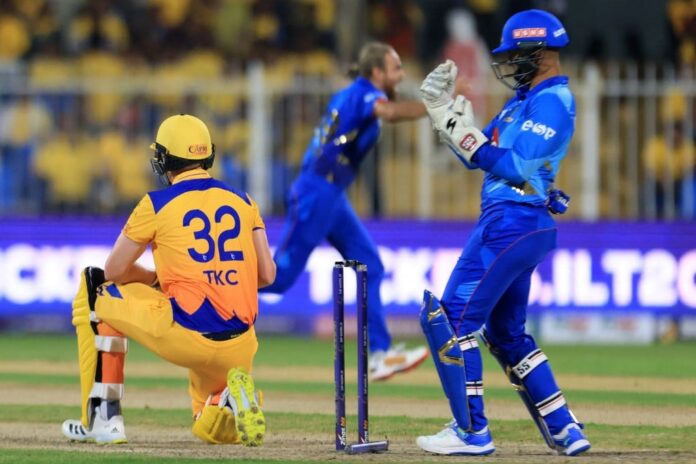Last Sunday, the final of the DP World ILT20 was played in front of a near capacity crowd in Dubai.
The previous day, at the Wanderers in Johannesburg, Sunrisers Eastern Cape beat the Pretoria Capitals in the final of the Betway SA20 tournament in front of a capacity crowd. Before the tournament started, there had been concerns about how the public would respond to the third attempt to establish a T20 franchise league in South Africa.
Those concerns were unrealized as crowds flocked to matches throughout the tournament. South Africa has a long-established history of cricket but, of late, the public has tired of its poor governance and political machinations. SA20 has reawakened public interest, as well as generating much needed income.
Innovations have been introduced to playing conditions. Captains could name 13 players before the toss and then omit two after the toss was made. Bonus points were on offer for teams which achieved a run rate 1.25 times that of their opponents.
SA20 has also provided a basis for previously unknown local talent to be showcased on the international stage. This objective was also a driving force behind the DP World ILT20. Unlike SA20, where no more than four overseas players were allowed, ILT20 squads were mandated to have four UAE players, with two of them having to be named in playing 11s.
At post-match press conferences, overseas players spoke glowingly of the contributions made by UAE players and how much they will have learnt in their cricketing development by mixing with those who have performed at the highest level. How this will be manifested in the future performance of the UAE team remains to be seen and is almost impossible to quantify. Analysis suggests that in terms of appearances, runs and wickets, the contribution of UAE players to their teams were variable.
Waseem Muhammad won the UAE player of the tournament award. He opened the batting for MI Emirates and played in every match, scoring 367 runs, with a highest score of 86. This placed him as the fourth-highest run scorer in the tournament as a whole, an outstanding achievement given the quality of international players in the competition.
Zahoor Khan was another UAE player favored by the MI Emirates. A right-arm fast-medium bowler, he played in nine of a possible 11 matches, taking eight wickets. The other two UAE players in the MI Emirates squad were chosen to play only once.
This pattern was the case in other squads. The Desert Vipers, Delhi Capitals, Gulf Giants and Sharjah Warriors all focused on two of their four UAE players in terms of selection. Only the Abu Dhabi Knight Riders gave a wider spread of opportunities to its UAE players.
The Warriors selected two bowlers in their lineups, Junaid Siddique and Muhammad Jawadullah, both of whom performed creditably. Similarly, the Gulf Giants selected both Aayan Khan and Sanchit Sharma for all of their matches. Rohan Mustafa opened the innings in all of the Desert Viper’s matches. As he revealed in a press conference, he played in a style that was not normal for him. This involved taking on bowlers from the first ball. His reward was 188 runs and, most probably, an enhanced understanding of the role of an opening batter in T20 cricket.
Opening batters are guaranteed involvement in the match. This is not always the case for bowlers. Aayan Khan, for example, played in 10 matches, but bowled only four overs and took two wickets. Those two wickets were gems.
The first tempted Alex Hales, the league’s highest run scorer, to pull a ball from outside off stump to the leg side boundary, straight to a fielder positioned there. The second tempted Sam Billings, when well set, to dive into the deep. Khan batted only three times. Sharma played in 11 matches and bowled in nine, being allocated 23 overs. Notably, he did not bowl in the second qualifying match, which the Giants had to win to reach the final, in which he bowled only one over.
It was also noticeable that Sheraz Ahmad Piya of the Desert Vipers, who played in eight matches, bowled only 10 overs and was not given an opportunity to bowl in the first qualifying match in the playoffs, which the Vipers won to progress straight to the final. It is understandable that teams led by seasoned international cricketers will not want to run the risk of exposing players inexperienced in such critical moments of play. Yet, how do they gain this experience?
In a press conference after the second qualifying match, when the Gulf Giants progressed to the final, Chris Lynn said the defeat by the Vipers in the first qualifier was an occasion that provided an opportunity to regroup and re-evaluate plans. This seemed to result in the sparse use of the UAE players in the remaining two matches, although their consolation is a winner’s medal and cheque.
The lack of these prizes was something which Moeen Ali reflected on after the Sharjah Warriors failed to reach the playoffs. He felt that he had tried to keep everyone happy, whereas the real motivation for players is to set out to win the tournament, with appropriate plans in place. The tension between giving local players opportunities for development and meeting the aspirations of experienced professionals is a management task which several teams performed better than others.
No doubt, this is a discussion which will take place with the franchises as they plan for 2024. The tournament organizers have reported that over 200 million people tuned in live to broadcasts on Zee’s various channels.
If similar dates apply next year, competition for players with SA20 will occur again. There, domestic players who did not play this year will be wanting to do so in 2024 and will be looking to develop relevant skills and produce performances which get them noticed. In the UAE, the emphasis is on getting more out of a limited pool of local talent.

